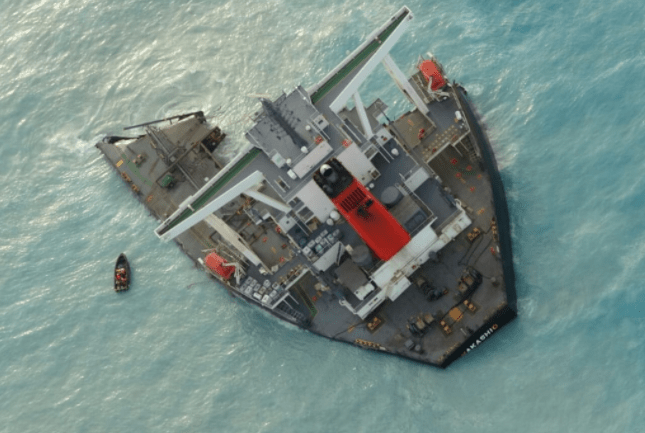Adverse weather conditions have greatly disrupted the dismantling of what remains of the stern of the “MV Wakashio” on the Pointe-d’Esny’s reefs, in Mauritius. The operation will resume at the earliest in September or, at worst, in October, local authorities announced after having ordered the tugs “Crest Mercury 3” and “Independence” to leave Tamarin Bay – where they were sheltering in the West – for Port-Louis’ harbor alongside “Hong Bang 6” and “Olympic Kapuas” barges.
After leaving China, the Wakashio was on its way to Brazil when it ended up on Pointe-d’Esny’s reefs on the night of Saturday, July 25, 2020. The accident occurred during an attempt to capture the island’s cell phone network so that the crew members could use WhatsApp to get in touch with their relatives. Some of them had been at sea for months due to the Covid-19 epidemic. The accident caused an oil spill a few days later.
The 225 meters of the front part of the boat, cut in two by the swells, had been sunk on August 24, 2020 in 3,180 meters of water some 20 nautical miles from the village of Old-Grand-Port. It was only six months later that the dismantling of the 75 meters of the stern had begun with the assistance of experts from the Chinese company Lianyungang Dali Underwater Engineering. The operation was supposed to be completed in March, but was delayed by the cyclone season and then with winter season.
The contribution of the “Hong Bang 6”, a crane barge specialized in this type of work and which is one of the three of this type in the world, was necessary for this exercise. The dismantled parts were placed on the barge before being transported to Port-Louis to be handed over to the Samlo company, a local specialist in recycling scrap metal. While waiting for the dismantling to be completed, the special court set up to shed light on this shipwreck continues to hear witnesses.
During the past week, former Commissioner of Police Khemraj Servansing was heard as the head of the Disaster Management Center and ultimate head of the National Coast Guard (NCG). He was confronted with the fact that the NCG misled Prime Minister Pravind Jugnauth regarding the accident by making him believe that there was a permanent radar surveillance of the coastline. He admitted that there was a slackening and that the officers in charge of this mission cannot perform administrative tasks at the same time.
Asked about the unavailability of police helicopters on the evening of the accident, he said there the two available for night patrol had some issues. The spare parts for one of those helicopters, the Fennec, had not been delivered and the largest police helicopter, the Indian-made Dhruv, was under maintenance. A second Dhruv, he reveaded, will be acquired for maritime surveillance and to prevent this type of accident.
For his part, the head of the NCG commando team, Indian Navy Officer Rajiv Lochan, dispatched from the Marcos, the “Marine Commandos” of Bombay, explained to the court that at least ten minutes would have been enough for his men to board the “MV Wakashio” when it was heading towards Pointe-d’Esny. But there was no helicopter available at that time.

